![]()
![]()
![]()
Use LEFT and RIGHT arrow keys to navigate between flashcards;
Use UP and DOWN arrow keys to flip the card;
H to show hint;
A reads text to speech;
12 Cards in this Set
- Front
- Back
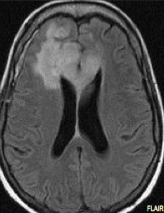
Is this an intra-axial mass or extra-axial mass?
|
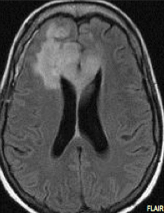
Intra-axial mass. it REPLACES or INFILTRATES brain tissue with no or minimal dural contact. Its origin is the brain or the spinal cord.
|
|

Is this an intra-axial mass or extra-axial mass?
|
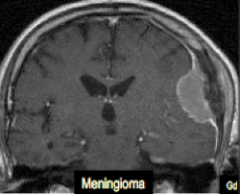
Extra-axial mass. it DISPLACES the brain, has a broad dural base, and the origin is the dura or the skull
|
|
|
What does a diffusion-weighted MRI (DWI) use to help us with diagnosing?
|
DWIs demonstrate the random motion of water (diffusion). Purulent fluid (pus, inflammatory cells, debris) has decreased diffusion, thus showing up as white on the image.
|
|
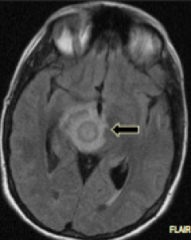
What is this? How might we treat it?
|
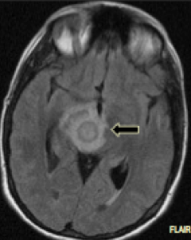
Brain abscess. Treat by surgical drainage or excision, or antibiotics if the abscess is small.
Abscesses are polymicrobial infections that are encapsulated by a fibrous cap. It's generally filled with pus. |
|
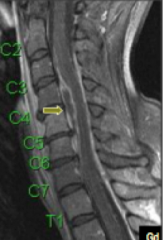
What is this? What clinical symptoms may present with this? What might have caused it?
|
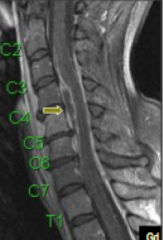
Spinal epidural abscess.
Symptoms: triad of fever, spinal painand neurologic deficits may be present. Pathophysiology: probably hematogenous, or direct extension from contiguous infection, or direct inoculation (knife, spinal surgery, etc.) |
|
|
Do we use imaging to diagnose meningitis? If so, what might you look for?
|
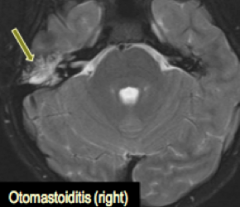
NO - we do not diagnose with imaging for meningitis. We use imaging to determine the CAUSE and COMPLICATIONS of meningitis.
The cause could be otitis media, otomastoiditis, paranasal sinus, odontogenic. Oh, and just for funsies, here's an MRI of meningitis due to otomastoiditis. |
|
|
What might show up on neuroimaging for viral encephalitis?
|
Grey matter predilection (except in HIV), bilateral but often asymmetric
|
|
|
What clinical presentations may show up for herpes encephalitis (HSV1)? Where are the most common foci of herpes encephalitis as shown on neuroimaging?
|

Clinical presentations: fever, seizures, focal neurologic signs, impaired consciousness
Neuroimaging: temporal, limbic, and orbitofrontal lobes bilateral and often asymmetric. NOTE: Herpes encephalitis is the most commonly fatal encephalitis. |
|
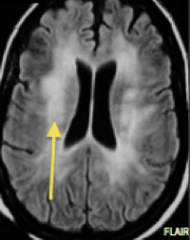
What is affected more here: grey matter or white matter?
Clue: this is viral encephalitis. What virus might this be? |
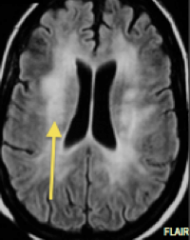
White matter is affected more here. Since this is viral encephalitis and WHITE matter is affected more, this must mean that this is caused by the HIV.
|
|
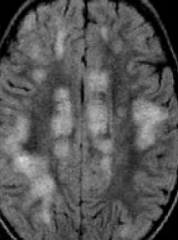
Describe acute disseminated encephalomyelitis (ADEM).
|
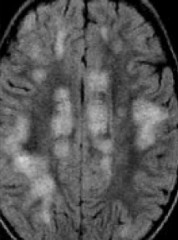
ADEM is a monophasic disease (disseminated in space, but not in time). It leads to demyelination 1-3 weeks after a viral infection.
|
|
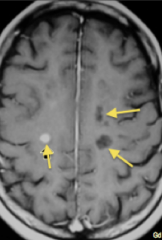
What might this Gd-enhanced MRI be showing?
|
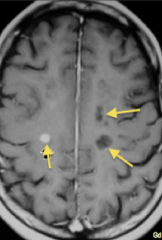
This is MS!
Note the multifocal lesions. There are white spots (more active demyelination), and the black holes (old attacks that have already undergone liquefactive necrosis) Note: metastases to the brain can also be multifocal - but they will show up as all white spots usually. |
|
|
What may neuroimaging reveal in normal aging of the brain?
|
larger ventricles, larger sulci, atrophy of frontal lobe, thalamus, and cerebellum.
|

